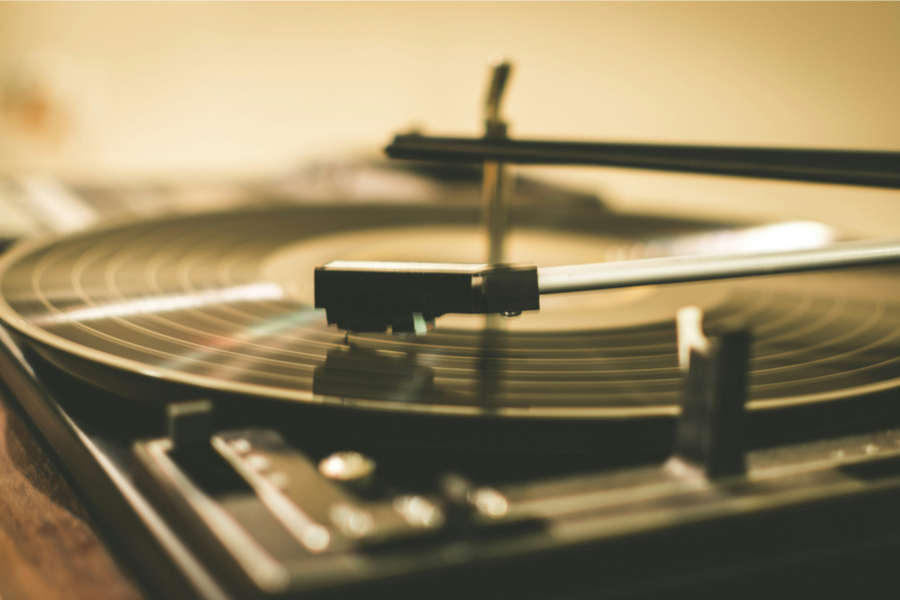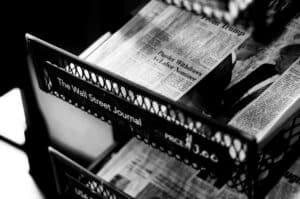At LifeBook Memoirs, we see it every day—nothing brings the past rushing back like music. One song can cue a lifetime of story.
Above any other medium, it is music that defines the last decades of the twentieth century in our memories and imaginations. On both sides of the pond, an explosion of new and splinter genres, the accessibility of listening to and owning music, and the perceived links with fashions and politics began in this postwar period. Never before had liking a particular band or singer come with its own implied personality—for better or for worse.
In this series, we will look back on the music from the 1950s to the 1980s, decade by decade, that provided the backing tracks of our LifeBook authors’ memories.
Music and memory
Music, when soft voices die,
Vibrates in the memory—
Percy Bysshe Shelley, 1821
Sound is a powerful sense to harness. Increasingly, music is being used to treat memory loss as well as trauma and even physical pain. In fact, listening to significant pieces of music is an exercise we often recommend to our authors to help them get started when preparing for their LifeBook interviews. As an easily accessible “time portal,” the songs we love can transport us into our past and trigger vivid memories in an instant.
It might come as no surprise that the music we love as teenagers has been scientifically proven to “hold disproportionate power over our emotions.” The neurological development experienced between the ages of twelve and twenty-two, intensified by growth hormones, means that everything we experience at this age is registered by our brains as important. So, when the pleasure neurochemicals released by listening to music flood our young brains, these significant songs lock into our memories and become forevermore sentimental. (Unfortunately, this strong relationship with the music of our youth is also why, the older we become, new music never sounds as good again!)
During a time when we are actively defining ourselves and making our own decisions about who we are and who we intend to be, the everyday high-drama events of our adolescence mold us. Daniel Levitin, author of This Is Your Brain on Music: The Science of a Human Obsession, says, “We are discovering music on our own for the first time when we’re young, often through our friends. We listen to the music they listen to as a badge, as a way of belonging to a certain social group. That melds the music to our sense of identity.”
It is no wonder, then, that youth-led subcultures came to steer, if not entirely pioneer, the sounds of the twentieth century.
While it is deemed an urban myth that teenagers were “invented” in the 1950s, it would seem that the roots of pop music, aimed at young consumers, did begin around this time. In 1958, Pathé News reported that 80 percent of new music was being bought by teenagers, accounting for 50 million record sales in the U.K. alone. In the U.S., where the demographic had more disposable income of any generation before them, the figure was 70 percent, and by the middle of the decade, most local television stations were broadcasting a weekly teen dance show. Undisputedly, in the 1950s, young people held a new type of power. But who were they listening to?
The great voices
By the turn of the new decade, America was well on its way to becoming the richest country in the world. Employment was high, and wages were on the rise. In the midst of this success and feeling of freedom after previous decades of depression and war emerged a new, romantic image of a glamorous American utopia.
Following on from the big band and swing era of the 1940s, the 1950s curated the careers of “the great voices.” Stars like Rosemary Clooney, Tony Bennett, Ella Fitzgerald, Johnny Mathis, Dean Martin, Billie Holiday, and Nat King Cole led a new kind of popular music focused on storytelling and emotion and influenced by Hollywood cinema.
The titan among these voices, of course, was Frank Sinatra. Though he had seen a decline in his career in the earliest years of the decade, he recovered with his Oscar-winning appearance in From Here to Eternity in 1953 and went on to become the first superstar. With his working-class-made-good persona, good looks, and salacious personal life, Ol’ Blue Eyes became a celebrity like none other. Musically, he is perhaps underrated for his skill and vision; leaving Columbia Records (where bosses had him singing songs about dogs) for Capitol in 1952, Sinatra developed his own consistent image, unswayed by what the label felt was public demand. He also pioneered the concept album—now a staple in pop—and even tried his hand at conducting.
It is worth noting, however, that by the time Sinatra’s star was on the rise again, he was approaching forty years old—not exactly the right age for a teen heartthrob. Despite this, however, Sinatra’s voice permeated through American suburbia and made him an aspirational icon of the decade, enduring to this day.
Rockabilly rebellion
In actuality, of course, only a small portion of Americans could relate to the vision of life that High Society presented or picture the places Sinatra sang about on his Come Fly with Me album. For many working-class people and people of color, life seemed to have changed very little.
A reaction was inevitable, and, as such, rockabilly was born. This new genre blended together rhythm and blues (known then as “race music”) and country music (“hillbilly” contributing to the latter part of the genre’s name). The genre was largely established by Black artists in Memphis, Tennessee, where record producer Sam Phillips began recording Black musicians in 1950. He recorded Rocket 88, performed by Jackie Brenston and written by Ike Turner, which is thought to be the very first rock and roll record. Musicians such as Chuck Berry and Fats Domino were also instrumental in the development of the genre.
Around this time, Phillips famously said, “If I could find a white boy who could sing like a Black man, I’d make a million dollars.” In due course, he was the first person to record Elvis Presley. Though arguably not its inventor, Elvis helped to make this transgressive sound the “international language of pop.” Acts like Jerry Lee Lewis, Buddy Holly, and Johnny Cash further made “The Devil’s Music” mainstream.
Music so outrageous needed a look, and with the rebellious “greaser” look having been popularized by films such as The Wild One (1953) and Rebel Without a Cause (1955), the two became intrinsically linked.
The term “greaser” does not, as is often believed, come from the slicked-back hair the teenagers styled; it originated as a slur for particular ethnic groups and was associated with manual labor. Greasers were generally working-class kids, often from Mediterranean or Latin American backgrounds. From the beginning, they were associated with street gangs, motorcycles, and hot-rod cars, along with a disillusionment with the American Dream.
These teenagers wore cuffed jeans, leather worker boots, and sleeveless undershirts or tank tops, which had previously only been worn as underwear. Young women could be greasers too, pairing leather jackets with bright lipstick and figure-hugging pedal pushers—a marked contrast to the preppy poodle skirt. It was a tougher, edgier kind of femininity. Before long, the greaser look was synonymous with the 1950s, later appearing in nostalgic depictions of the decade, like Grease (1971) and Happy Days (1974).
Between the transgressive music and the controversial casual dress, teenagers often encountered backlash from their parents. In his LifeBook, one author recalled his father coming into his room and taking away his Little Richard record, telling him that he wasn’t allowed to listen to “race music.”
To appease these kinds of qualms, record labels pushed safer, cleaner-cut white artists like Pat Boone, who covered many R&B hits. Then, from 1957, American Bandstand, presented by “the world’s oldest teenager,” Dick Clark, promoted rockabilly music, further cleaning up the genre’s image. Obviously, positioning the music for a wider, more conservative audience only made it less cool for teenagers, so the genre had to undergo yet another revolution as the decade came to a close. Yet, the rockabilly revolution had only just begun and, in one form or another, it still thrives to this day.
Flick knives, dance music, and Edwardian suits
Across the pond, Britain had not seen any such economic boom following World War II, and the country’s young people still had much responsibility to look ahead to, with leaving school at fifteen and young men anticipating their National Service at eighteen.
The children who had been evacuated from the cities to the countryside, perhaps in reaction to the trauma of their early years and the adults’ desperation to resume normality, took a marked step away from the shapeless utility-wear and demob suits worn by their parents and adopted the Edwardian-style tailoring being promoted by Savile Row at the time. The Teddy Boys (and some Teddy Girls too, called “Judies”) sought to introduce some optimism, glamor, and dignity to their lives in the bombed-out cities of Britain.
Though the visual hallmarks of the Teddy Boy were introduced by the elite, the movement was dominated by working-class teenagers who made the style their own with Western-type bootlace ties and “brothel-creeper” shoes with thick crepe soles. Of course, what the working class adopted, the middle class rejected; as one journalist wrote, after fashion writers had predicted Edwardian suits would become fashionable, “… no well-dressed man would be seen in such an outfit. The idea has been killed stone dead by youths with more money than dress sense.”
While Teddy Boys eventually became associated with rock and roll, they pre-date the genre and were originally listening to skiffle, blues, and jazz—music that spoke to working-class struggle. They also slow danced to The Creep by Yorkshire Big Band leader Ken Mackintosh, earning them another nickname: “Creepers.”
The Teddy Boys went on to influence music too. On the Mersey Beat scene, The Beatles, in their earliest days, wanted to emulate the style, and Paul McCartney later wrote the song Teddy Boy, recalling the concerns of the age: “If his mother said, Ted be good, he would; She told him tales about his soldier dad, but it made her sad … Ted used to tell her he’d be twice as good …”
Unfortunately, it was also music that amplified the negative public perception of “Teds.” In 1956, the movie Blackboard Jungle, featuring Bill Haley’s Rock Around the Clock and advertised as “the most startling picture of the year!”, was released in theaters. In Elephant and Castle, London, local Teds jived in the aisles while others tore up the seats. When their behavior appeared in the newspapers, copycats sprang up elsewhere, nurturing a perception about the new music imported from America and juvenile delinquency.
The movement’s reputation for violence was already well established after a fatal clash involving a gang of Teddy Boys occurred in South London in 1953—the Daily Mirror ran the headline Flick Knives, Dance Music, and Edwardian Suits—but the Blackboard Jungle incident would go down in infamy. The Teddy Boys were further harmed when some journalists began to refer to any white working-class person involved in the 1958 Notting Hill race riots as “Teddy Boys.” Whether the generalization was accurate or not, the police were supposedly getting “tough on Teddies,” and with the decade drawing to a close, it was time for a new movement to step into its place.
The Teddy Boys did see a brief rebirth in the 1970s, revived by those who listened to the rockabilly music of their parents’ youth, but it was never the same again. The original Teddies referred to this new wave of followers as “plastics.” As we’ll get to, teenagers had other uniforms—and music—for their rebellion in that era.
Before we move into that period, though, it’s worth pausing on what the 1950s taught us: that music wires memory to moments. From crooners to rockabilly to Teddy Boys, a single special song can pull a whole scene back to mind. Records from that time don’t just play; they store places, faces, and feelings that you can reach in a heartbeat. Sinatra’s polish, rockabilly’s spark, the swagger of the Teds—together, they show how a decade set life to music.
Did this article prompt any memories of the music of your own youth? Contact LifeBook Memoirs today to enquire about preserving your stories for your family.
Written by Isabella Samuels, LifeBook Memoirs editor




